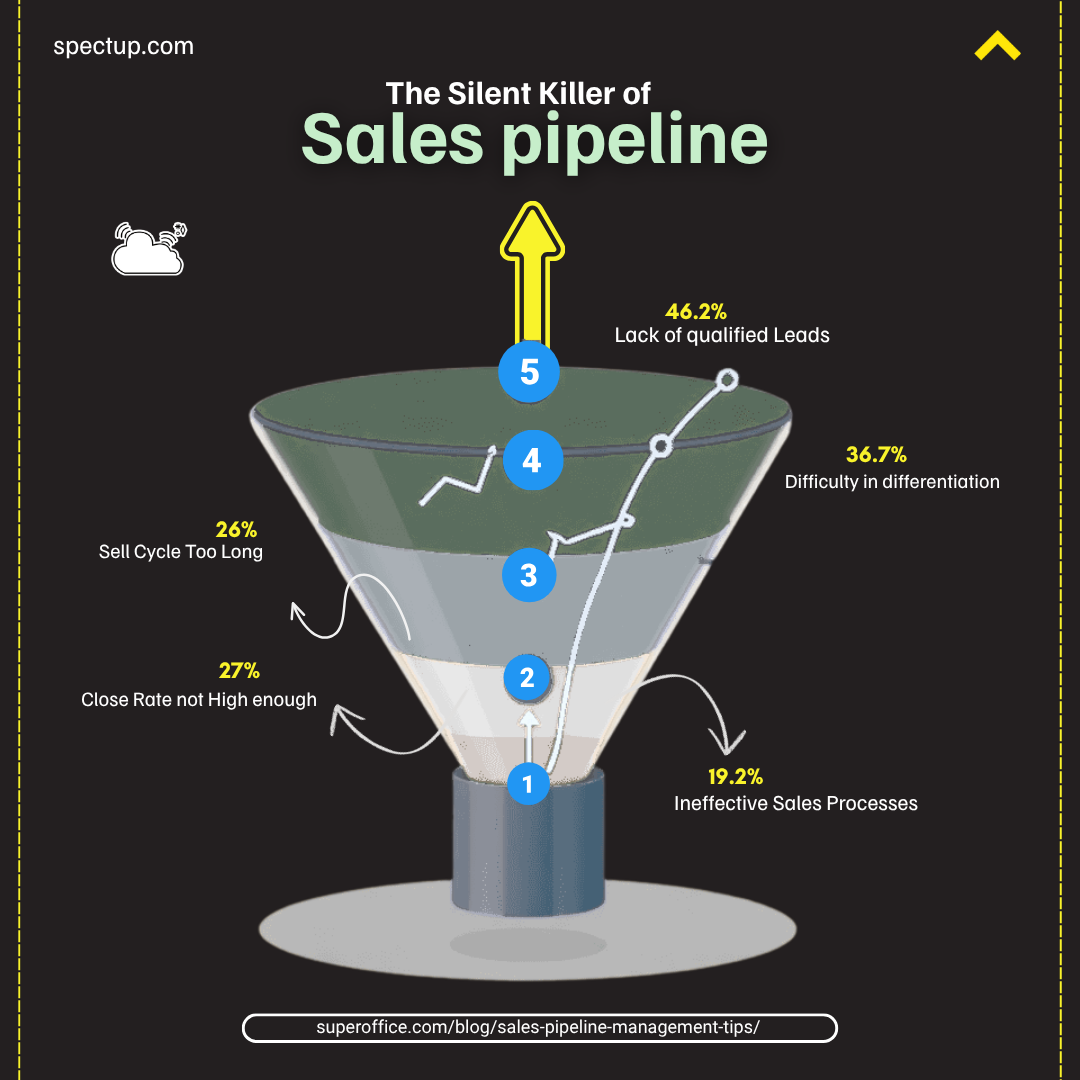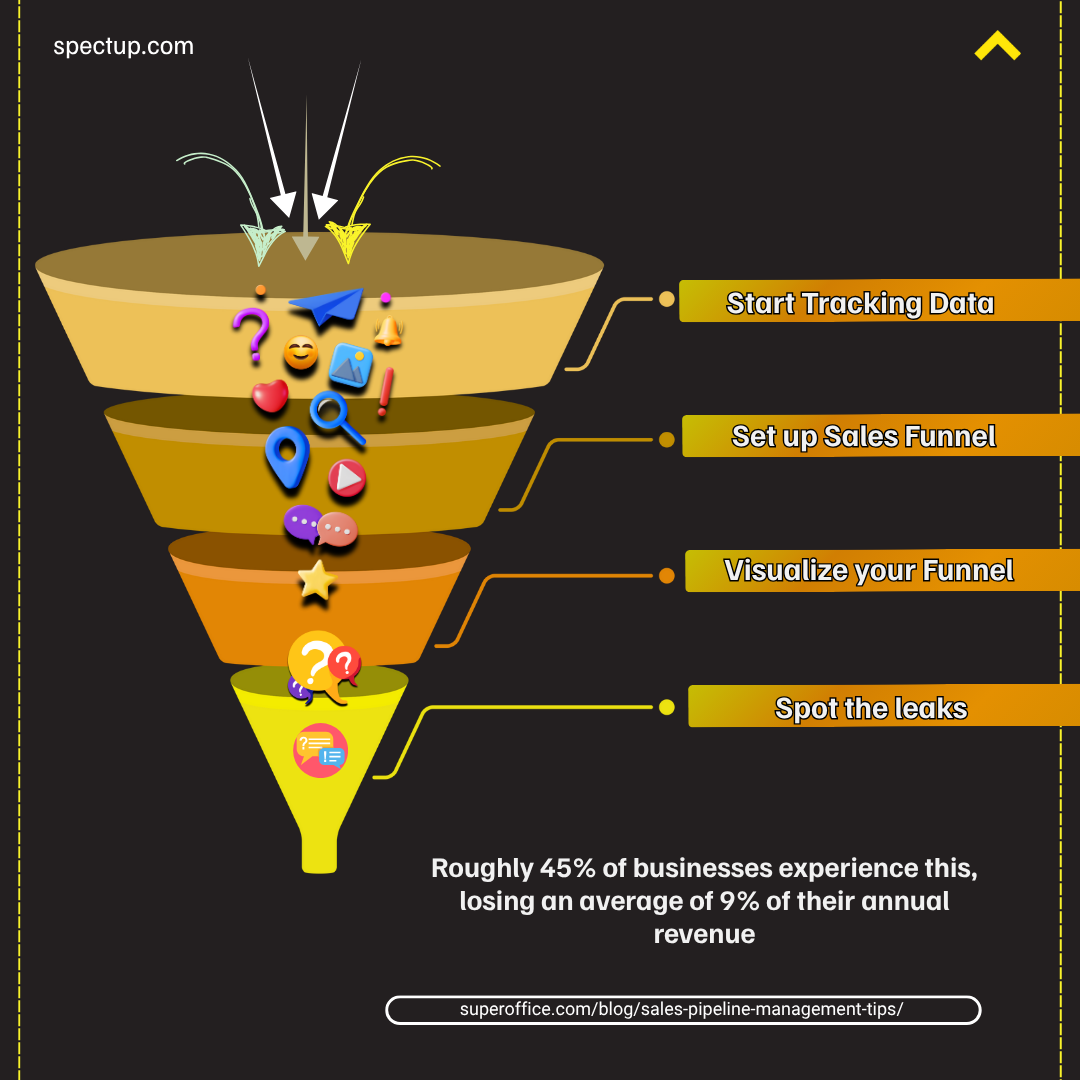The Silent Killer of B2B Growth: Inconsistent B2B Sales Pipeline & How to Fix It

Understanding the B2B Sales Pipeline in Business
In the ever-changing business landscape, grasping the intricacies of a sales pipeline is essential. As leads progress through different funnel stages, businesses have multiple chances to enhance their strategies. This is especially vital for startups entering new industries such as AI, mobile app development, or ecommerce.
With the diversified and swift shift to Generative AI startups, there's a significant shift in how businesses approach their sales strategies. Therefore, understanding your sales pipeline is not just about tracking leads; it's about maximizing every opportunity that comes your way.
What Is a Sales Pipeline, Really? (And Why Founders Misunderstand It)
An inconsistent sales pipeline can silently hinder B2B growth, causing various problems for businesses. Founders mostly misinterpret its true meaning that can be especially harmful in industries like HealthTech, where new technologies offer both opportunities and challenges that require a clear and consistent sales strategy to overcome.
Common Founder Misconceptions
- Thinking more leads equal more revenue
- Confusing top-of-funnel activity with pipeline strength
- Treating CRM as a reporting tool rather than a system of action
- Ignoring pipeline conversion rates and cycle times
Understanding how unpredictable revenue streams affect business growth is crucial. A healthy pipeline has:
- Each stage clearly defined with exit criteria
- Consistent lead volume monthly
- Stable pipeline conversion rates between stages
- Clear ownership across marketing, SDR, and sales roles
- Pipeline fForecasting based on past performance metrics, not gut feelings
Additionally, the impact of quantum computing on startup innovation could also help by providing new tools and methods that can improve pipeline management and forecasting accuracy.
Understanding the Inconsistent B2B Sales Pipeline Problem
An inconsistent sales pipeline is like a leaky bucket. You keep pouring in leads, but many slip through the cracks before turning into revenue. Recognizing these sales funnel leaks helps you tackle the root issues dragging down your B2B growth.
Understanding how to fix pipeline issues begins with identifying exactly where the leaks occur and why they happen in the first place.
Common Symptoms & Causes
Here are some common symptoms and causes of an inconsistent sales pipeline:
- Irregular lead flow: Sometimes leads flood in, other times it’s a desert. This unpredictability stalls momentum
- Weak inbound marketing: Without a steady stream of quality content and SEO efforts, attracting ideal prospects becomes a guessing game.
- Unclear marketing attribution: When you can’t track which campaigns actually deliver deals, budget and effort get wasted.

Risk Factors That Worsen Pipeline Inconsistency
The following pipeline inconsistency risks can worsen your sales pipeline issues:The following risk factors can worsen pipeline inconsistency:
- Poor audience segmentation: Targeting everyone means appealing to no one. Your message gets lost in noise.
- Sales and marketing misalignment: Teams pointing fingers instead of collaborating create gaps in lead qualification and follow-up.
- Inefficient use of resources: Mismanagement of resources, such as pitch deck costs, can lead to inconsistent messaging and branding, further exacerbating pipeline issues.
Team & Operational Risks
Here are some team and operational risks that can contribute to an unhealthy sales pipeline:
- Sales and marketing teams blaming each other for missed targets.
- Pipeline inflation or sandbagging, where deals are overstated or purposely delayed to hit quotas later.
- SDRs chasing unqualified leads due to unclear criteria.
- Founders stepping in at the last minute to rescue deals, disrupting process discipline.
Business Risks from an Unhealthy Pipeline
An unhealthy sales pipeline can lead to several business risks, including:
- Missed revenue targets and broken forecasts that rattle leadership confidence. Understanding the difference between forecasting and projection can help in setting more realistic targets.
- Poor cash flow predictability leading to cautious hiring or stalled expansion plans.
- Disrupted customer onboarding as sales handoffs break down.
- Difficulty raising funding because traction metrics look shaky or inconsistent.
Fixing these B2B sales pipeline issues requires more than patchwork solutions.
Diagnosing Pipeline Leaks: Where and Why They Happen
Understanding where leaks occur in your sales pipeline is crucial for optimizing your conversion rates and improving your overall sales performance.
The Impact of the Gig Economy on Sales Pipelines
One significant area to consider is the gig economy, which has transformed traditional employment models. By leveraging freelance talent, startups can access cost-effective and flexible resources that can help fill gaps in the sales pipeline. However, if not managed properly, this flexibility can also lead to potential leaks in the pipeline.
Top-of-Funnel Leaks
Top-of-funnel leaks refer to issues that occur at the beginning stages of your sales process, where leads are generated but not effectively converted into qualified opportunities. Here are some common reasons for top-of-funnel leaks:
- Leads not ICP-aligned: If your leads do not align with your Ideal Customer Profile (ICP), they are less likely to convert into paying customers.
- Poor lead quality from paid channels: If you rely on paid channels for lead generation, ensure that the quality of leads coming from those channels is high. Regular assessment is very crucial and plays a pivotal role.
- No lead scoring or qualification criteria: Without a proper lead scoring system or qualification criteria in place, it becomes difficult to identify which leads are worth pursuing.
- Low MQL→SQL conversion rate: If you're experiencing a low conversion rate from Marketing Qualified Leads (MQLs) to Sales Qualified Leads (SQLs), it indicates a gap in your lead handoff process. Collaborate closely with your marketing team to improve this transition.
One effective way to address these issues is by seeking professional guidance from top consulting firms for startups. These firms can provide valuable insights into defining your ICP, improving lead quality, and implementing efficient lead scoring systems.
Mid-Funnel Leaks
Mid-funnel leaks occur when opportunities are generated but fail to progress further down the sales pipeline. Here are some common reasons for mid-funnel leaks:
- Undefined sales stages or inconsistent process: If your sales stages are not clearly defined or if there is inconsistency in how different sales reps follow the process, it can lead to confusion and delays in closing deals.
- Lack of content/supporting materials for buyer objections: Buyers often have objections or concerns that need to be addressed before they can move forward with a purchase decision.
- No playbooks for key segments or verticals: If you have specific target segments or verticals where you want to focus your efforts, create playbooks that outline tailored approaches for each segment. This will help your sales team navigate conversations more effectively.
- CRM hygiene issues: lost data, wrong stage, outdated contact info: Maintaining accurate and up-to-date information in your CRM system is crucial for effective CRM pipeline management and minimizing mid-funnel leaks.Customer Relationship Management (CRM) system is crucial for effective pipeline management.
In addition, it's essential to consider the impact of remote work on startup culture and collaboration. Understanding these changes can help in adapting strategies that align with the new working environment, thereby reducing mid-funnel leaks.
Bottom-of-Funnel Leaks
Bottom-of-funnel leaks refer to situations where deals are close to being won but encounter obstacles that prevent finalization. Here are some common reasons for bottom-of-funnel leaks:
- Deals stuck in “verbal yes” limbo: Sometimes, prospects may verbally agree to move forward but delay in signing contracts or making payments.
- Pricing and proposal confusion: If there is ambiguity or confusion around pricing structures or proposals, it can lead to delays in decision-making.
- Lack of technical validation or integration pre: For deals involving technical products or services, it's essential to validate any technical requirements early on.
- Poor handoff to onboarding/success teams: Once a deal is closed, a smooth transition from sales to onboarding/success teams is critical for customer satisfaction. Establishing clear handoff processes and communication channels between these teams can help mitigate potential issues.
- Need for Agile Methodologies: Embracing Agile Methodologies can be beneficial for startups facing these bottom-of-funnel leaks.
- Building a Strong Startup Culture: A vibrant startup culture that keeps remote and in-office teams connected can also play a significant role in reducing bottom-of-funnel leaks.
- Understanding Venture Capital Investment Decisions: Finally, if your startup is seeking venture capital funding, it's essential to understand how venture capitalists make investment decisions.
Pipeline Health Metrics to Track
To effectively diagnose pipeline leaks, it's important to track key sales pipeline metrics that provide insights into the health of your pipeline. Here are some metrics you should monitor:
- Volume of opportunities by stage: Understand how many opportunities exist at each stage of your pipeline.
- Stage-by-stage conversion rates: Analyze the conversion rates between different stages of your pipeline.
- Sales velocity (deal value x win rate / sales cycle): Calculate the velocity at which deals move through your pipeline by considering deal value, win rate, and sales cycle length.
- Pipeline coverage ratio (pipeline value ÷ quota): Assess whether you have enough pipeline coverage relative to your sales quota by comparing total pipeline value against quota targets.
- Aging reports: Review aging reports that show how long deals have been sitting in each stage of the pipeline.
By understanding these common leak points, you will be able to enhance the workflow of your startup. Finally, when it comes to presenting your ideas to potential investors or studios, personalizing your pitch deck for every funding stage from pre-seed to series C is essential. Our resource on pitch deck funding stages provides valuable insights into this process.
Aligning Sales and Marketing to Fix Pipeline Issues
Align Your GTM Strategy Around the Pipeline
- Tighten ICP definitions between marketing, SDRs, and AEs
- Revisit buyer personas and segmentation
- Ensure lead scoring matches actual buyer behavior
- Map content and messaging to each funnel stage
Standardize Sales Stages and Exit Criteria
- Define clear, milestone-based progression rules
- Train sales team on qualification frameworks (e.g., MEDDIC, BANT)
- Use sales enablement tools (battlecards, objection handling)
- Automate CRM triggers and stage advancement rules
Build Accountability With Pipeline Reviews
- Conduct weekly or bi-weekly pipeline reviews using a structured format.
- Ensure that sales representatives are held accountable for maintaining deal hygiene and providing accurate forecasts.
- Utilize visual dashboards to identify potential risk areas at an early stage.
- Have the founder or head of sales personally review deals that are stuck in the pipeline.
Invest in Pre/Post-Sales Integration
- Conduct pre-sales engineering or onboarding preview during late-stage deals
- Set expectations with customer success during the proposal phase
- Use mutual action plans (MAPs) to align buyer and seller timelines
- Track post-close churn and retroactively analyze pipeline fit to ensure the product aligns with market needs
- Understand the implications of pre-money vs post-money valuations during the investment phase
Building a Continuous Demand Generation Strategy for a Consistent Pipeline Flow
To maintain a steady flow of leads and opportunities in your sales pipeline, it's crucial to implement an always-on demand generation strategy.
Tools to Support Scalable Pipeline Management
To effectively manage and scale your pipeline, you'll need to use various tools and technologies that can make your processes more efficient and provide valuable insights. Here are some key tools to consider:
1. CRM: Use a customer relationship management (CRM) system like HubSpot, Salesforce, or Pipedrive to centralize all your leads, contacts, and deals in one place.
2. Lead routing and qualification: Implement lead routing and qualification tools such as LeanData or Chili Piper to ensure that incoming leads are assigned to the right sales representatives based on predefined criteria.
3. Sales enablement: Equip your sales team with the resources they need to engage prospects effectively by using sales enablement platforms like Gong, Highspot, or Showpad.
4. Analytics: Gain visibility into your pipeline performance by leveraging analytics tools such as Clari or InsightSquared.
5. Playbooks and SOPs: Document best practices and standard operating procedures (SOPs) for your sales processes using tools like Notion or Confluence.
However, managing a startup pipeline is not just about the tools you use but also about building a resilient startup culture in a hybrid work environment. For those seeking investment opportunities or looking to streamline due diligence processes, spectup offers expert venture capital consulting, which could be beneficial.

Key Hires to Strengthen the Pipeline
As you scale your operations, it's important to bring in key hires who can strengthen different aspects of your pipeline management. Here are some roles to consider:
- SDR manager or pipeline operations lead: Hire an SDR (Sales Development Representative) manager or pipeline operations lead who can oversee the day-to-day activities of your SDR team.
- RevOps specialist for CRM, data, and reporting: Bring on a RevOps (Revenue Operations) specialist to unify your GTM data streams. RevOps for startups helps align marketing, sales, and customer success for better pipeline visibility and forecasting.
- Sales enablement or onboarding lead: Consider hiring a sales enablement or onboarding lead who can design training programs and resources for new sales hires.
- Customer success ops for post-sale retention and NRR insights: If you have a customer success team, it's beneficial to have someone dedicated to operations within that function. This individual can focus on post-sale retention efforts (keeping existing customers happy) as well as tracking net revenue retention (NRR) metrics which indicate how much revenue you're retaining from existing customers over time.
By implementing these tools and making strategic hires within your organization, you'll be well-equipped to build an effective continuous demand generation strategy that drives consistent pipeline flow.
Founder’s Role in Pipeline Predictability
As a founder, your role in ensuring pipeline predictability is crucial. Here are some key actions you should take:
What Founders Must Do
- Document and delegate their sales approach
- Set standards for qualification, forecasting, and follow-up
- Invest in sales training and coaching
What Founders Must Stop Doing
- Stop chasing deals themselves once the team is in place
Investor Signals: What a Healthy Pipeline Communicates
Signals That Increase Investor Confidence
A healthy pipeline can communicate a lot to potential investors. Here are some key signals that can increase their confidence in your business:
- 3–4x pipeline coverage with predictable close rates: This means that for every dollar you want to generate in revenue, you have three to four times that amount in your pipeline. Additionally, you should have a good understanding of how many deals will close based on your historical data.
- CRM screenshots with clean, structured funnel flow: Your customer relationship management (CRM) system should show a clear and organized flow of leads through the sales process. This indicates that you have a systematic approach to managing your sales pipeline.
- Consistent growth in qualified pipeline quarter-over-quarter: It's important to demonstrate that your qualified pipeline is growing steadily from one quarter to another. This shows that you are consistently attracting high-quality leads and opportunities.
- Conversion rates that improve as the team learns: As your sales team gains experience and learns from their interactions with prospects, you should see an improvement in conversion rates. This indicates that your team is becoming more effective at closing deals.
- A sales motion that doesn’t rely on founder heroics: While founders often play a crucial role in early-stage sales, it's important for the long-term success of the business that the sales process does not solely depend on their efforts. Investors will be looking for evidence that the sales motion can operate independently of the founder's involvement.
By showcasing these signals through data and metrics, you can instill confidence in potential investors and demonstrate the health of your pipeline.
If you're looking for additional guidance on how to effectively manage these aspects and prepare your startup for investor scrutiny, consider exploring the Lean Startup model, which offers valuable insights into smarter, faster business growth.
Conclusion
Inconsistent pipelines can be a silent killer of B2B growth. To unlock sustainable growth, it's crucial to proactively audit your pipelines and ensure consistency in your processes.
Don't wait for chaos to ensue. Take control of your growth strategy today and make consistency a priority. Whether you're seeking startup accelerators for rapid growth, looking for ways to secure a startup business loan with no revenue, or mastering the art of bootstrapping, remember that every little step counts towards achieving your growth objectives.
An inconsistent sales pipeline leads to unpredictable revenue, missed targets, and broken forecasts. Causes include irregular lead flow, weak inbound marketing, unclear marketing attribution, poor audience segmentation, and sales-marketing misalignment.
Founders should understand that more leads do not automatically mean more revenue. They must distinguish top-of-funnel activity from actual pipeline strength, use CRM as a system of action rather than just reporting, and pay close attention to pipeline conversion rates and sales cycle times to maintain healthy pipeline metrics.
A healthy pipeline has clearly defined stages with exit criteria, consistent monthly lead volume, stable conversion rates between stages, clear ownership across marketing, SDRs, and sales roles, and forecasting based on historical performance metrics. This structure ensures predictable revenue flow and efficient sales processes.
Diagnosing leaks involves analyzing top-, mid-, and bottom-of-funnel issues such as poor lead quality, undefined sales stages, lack of playbooks for key segments, CRM hygiene problems, deals stuck at closing stages due to pricing or technical validation issues.
What strategies help align Sales and Marketing teams to improve pipeline consistency?
Key hires include SDR managers or pipeline operations leads, Revenue Operations specialists for CRM/data/reporting oversight, sales enablement/onboarding leads, and customer success operations personnel focused on post-sale retention and net revenue retention tracking.
Concise Recap: Key Insights

Ready to Take the Next Step?
Whether you're a startup looking for funding or an investor seeking prime opportunities, we're here to help.
Contact Us
.png)

